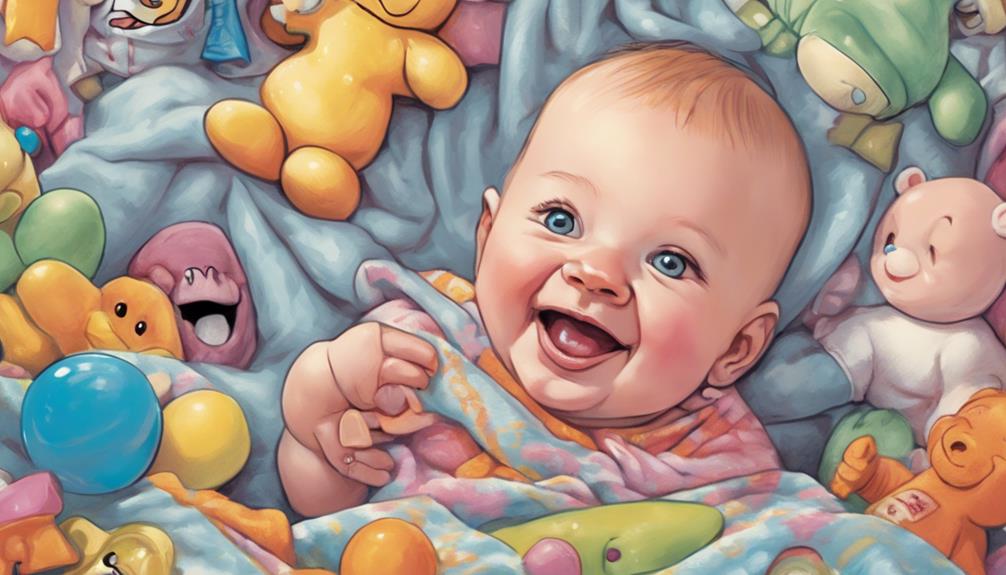Your baby's first teeth are usually the lower central incisors, which typically come in between 6 to 10 months of age. After that, the upper central incisors usually appear around 8 to 12 months. You might notice some signs of teething discomfort during this time, like increased drooling and irritability. To soothe your little one, try chilled teething rings or a clean washcloth. Establishing good oral hygiene early is essential, too. If you're curious about the complete timeline and how to manage teething symptoms effectively, there's much more to discover about this journey!
Key Takeaways
- The first teeth to emerge are the lower central incisors, typically appearing between 6 to 10 months of age.
- Upper central incisors usually follow, erupting around 8 to 12 months, about 4 to 8 weeks after the lower ones.
- Lower lateral incisors typically come in between 10 to 12 months, continuing the pattern of tooth emergence.
- After the incisors, the upper lateral incisors generally erupt between 9 to 11 months.
Understanding Teething

Teething is a natural process that typically starts when babies are around 4 to 7 months old, marking the beginning of their dental journey. As a parent, you'll notice that the first teeth to come are usually the lower central incisors. These little teeth often break through the gums first, followed by the upper central incisors about 4 to 8 weeks later.
When babies start teething, you might observe various signs of discomfort. Your baby may drool more than usual, become irritable, or even show swollen gums. These symptoms can vary considerably from one infant to another, so it's crucial to stay attentive to your child's needs.
To soothe your baby during this challenging time, consider using teething rings or gently massaging their gums with a clean finger. You can also try cold washcloths to help alleviate teething pain.
Understanding the teething process and its symptoms helps you manage your baby's discomfort more effectively, ensuring they feel supported as they begin this important milestone.
Timeline of Tooth Eruption
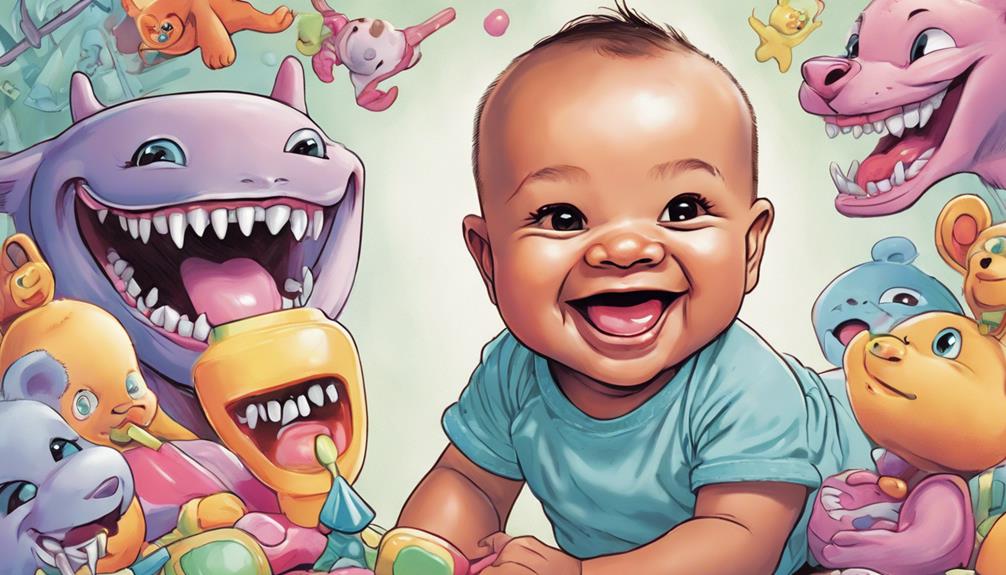
As your baby navigates the teething phase, you'll witness a specific timeline for tooth eruption that outlines when each set of teeth typically appears.
The first teeth to emerge are usually the lower central incisors, which you'll see between 6 to 10 months. Shortly after, around 8 to 12 months, the upper central incisors will make their entrance.
Next up are the lateral incisors. The bottom lateral incisors typically erupt between 10 to 12 months, while the upper ones appear between 9 to 11 months.
As your baby approaches 13 to 19 months, the first molars will come in, followed by the canines, which usually emerge between 16 to 22 months.
First Teeth to Appear
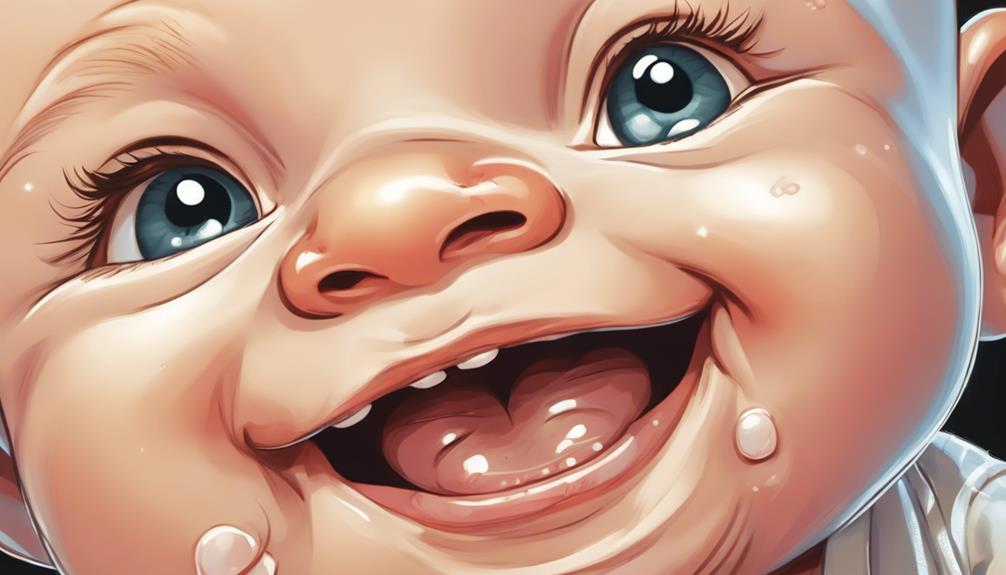
When your baby starts teething, you'll likely notice the lower central incisors making their debut first, usually between 6 to 10 months.
After that, the upper central incisors and lateral incisors follow in a specific order.
However, keep in mind that every infant's teething timeline can vary.
Understanding this order can help you anticipate what's next in your baby's dental development.
Central Incisors Eruption Timing
The central incisors typically make their debut between 6 to 10 months of age, with lower ones usually appearing before the upper ones. As a parent, you might find this an exciting milestone in your baby's development.
The eruption of these tiny teeth can be an eventful time, often marked by teething symptoms like:
- Increased drooling
- Gum sensitivity
Most babies will have their first tooth by their first birthday, and the lower central incisors often come in first, typically around 6 to 8 months. Upper central incisors usually follow, emerging between 8 to 12 months. This age range can vary a bit from one baby to another, but it's important to keep an eye on your little one for signs of teething. Once the first few teeth have come in, the rest of the baby teeth development typically progresses in a similar pattern. The lateral incisors, canines, and molars will follow in the coming months, usually completing the set of 20 primary teeth by the age of 3. It’s important to establish a good oral hygiene routine early on to maintain the health of these baby teeth and set the stage for the development of permanent teeth.
While you might feel anxious during this time, remember that the eruption of central incisors plays a significant role in your baby's oral development.
These first teeth not only help with chewing but also aid in speech development, setting the stage for a healthy set of babies' teeth to follow.
Order of Tooth Emergence
Understanding the order in which your baby's teeth emerge can help you anticipate their development milestones and manage teething discomfort more effectively.
Typically, the first teeth to appear are the lower central incisors, which usually erupt between 6 to 10 months. Shortly after, around 8 to 12 months, the upper central incisors come in.
Next in the order of tooth emergence are the lower lateral incisors, appearing between 10 to 12 months, followed by the upper lateral incisors, which emerge from 9 to 11 months.
As your baby continues to grow, the first molars generally erupt between 13 to 19 months, providing additional chewing capability.
Canines, or cuspids, make their appearance around 16 to 22 months, rounding out the early set of teeth.
Finally, the second molars emerge last, with the lower ones erupting between 25 to 33 months and the upper ones following shortly after.
Knowing this order can help you track your baby's dental development and prepare for the teething challenges that may arise along the way.
Variability Among Infants
Variability in the timing of your baby's first teeth can be quite surprising, with some starting to teethe as early as 3 months and others not until they reach a year old. This variability among infants means that you might see a range of experiences as your baby's teeth begin to emerge.
Here are a few key points to reflect on:
- Most babies typically get their first tooth, the lower central incisors, between 6 to 10 months old.
- Upper central incisors usually follow, appearing around 8 to 12 months after the lower teeth start coming in.
Keep in mind that every baby is unique, and teething can sometimes be a lengthy process filled with discomfort.
Watching for signs of teething, like increased drooling or fussiness, will help you prepare for when those first teeth begin to show.
Understanding this variability can ease your concerns and help you celebrate each milestone as it comes.
Common Teething Symptoms

When your baby starts teething, you might notice several common symptoms.
Increased drooling, fussiness, and swollen gums often signal that teeth are on the way.
You may also see changes in their sleep patterns as they navigate this uncomfortable phase.
Increased Drooling and Fussiness
Teething often brings about increased drooling and fussiness in babies, making this a challenging time for both infants and their caregivers. As those first teeth make their way through the gums, you'll likely notice your little one experiencing discomfort and irritability. This process usually begins around 3 months of age, leading to a variety of common symptoms.
Increased drooling: Your baby may soak through bibs as they drool more than usual.
Fussiness: You might find your baby more irritable and difficult to soothe during this period.
Chewing and gnawing: Your infant may chew on fingers or toys, seeking relief from the pressure of erupting teeth.
The discomfort from teething can cause sleep disruptions, making naps and bedtime challenging. While a slight increase in body temperature might occur, remember that a true fever typically indicates another issue.
Recognizing these signs can help you provide the comfort your baby needs during this uncomfortable phase, allowing both of you to navigate teething together.
Swollen Gums and Irritability
As your baby experiences increased drooling and fussiness, you might also notice swollen gums and heightened irritability, making this teething phase particularly tough. The discomfort often arises when the first teeth, typically the lower central incisors, begin to emerge around 6 months of age. This pressure can lead to significant irritability, causing your little one to feel restless and cranky.
Swollen gums are a common symptom during this time, and they can make your baby feel uncomfortable. You may also observe that the increased drooling, which often starts around 3 months, intensifies as teething progresses. While a slight elevation in temperature can occur, it usually remains below 102°F. It's important to monitor this, as a true fever might signal an unrelated illness.
To help ease your baby's discomfort, providing comfort is vital. You can try using teething gels to soothe swollen gums, offering a temporary relief that can calm irritability. Additionally, gentle gum massages with a clean finger can be comforting.
Changes in Sleep Patterns
Discomfort from emerging teeth often disrupts your baby's sleep patterns, making it harder for them to settle down at night. As teething progresses, you might notice your little one experiencing increased fussiness and irritability, leading to more frequent awakenings. This disruption can result in shorter sleep durations, as your baby struggles with sore gums and the overall discomfort of teething.
Here are some common signs you might observe during this phase:
- Difficulty falling asleep or staying asleep
- Increased irritability and fussiness during bedtime
It's essential to monitor sleep patterns during this challenging time. The good news is that these sleep disturbances are usually temporary and will resolve as your baby's teeth erupt fully, typically between 6 and 12 months of age.
To help ease discomfort and promote better sleep, implement comfort measures like gentle gum massages or teething toys.
Soothing Teething Discomfort
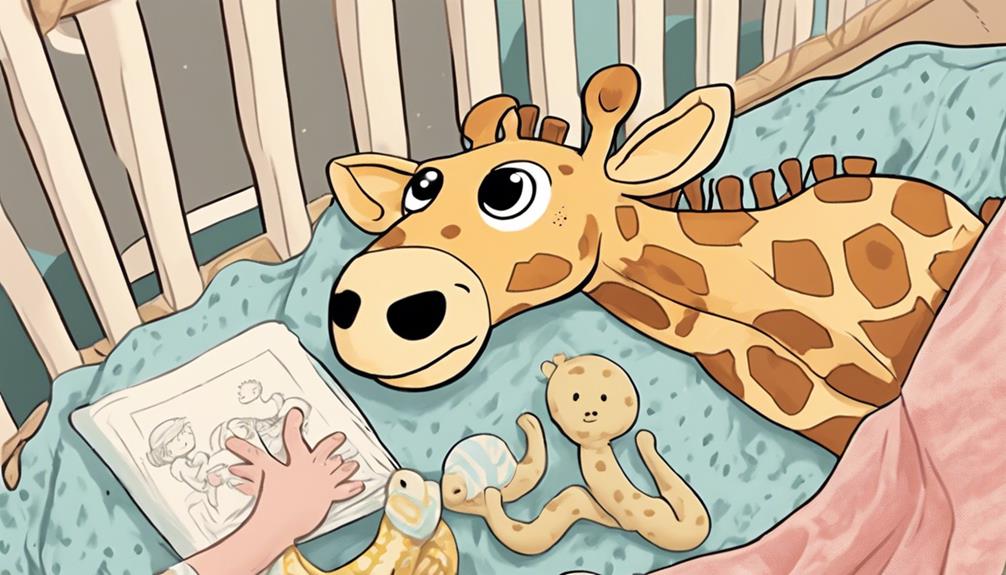
Soothe your baby's teething pain with cold items like chilled teething rings or frozen washcloths that numb their gums effectively. These cold items can provide immediate relief from the discomfort caused by erupting teeth. When your baby seems irritable, try gently massaging their gums with a clean finger—this can also help alleviate teething pain.
Teething biscuits are another option, but be cautious. Always supervise your baby while they chew to prevent choking hazards. If you notice any severe symptoms, such as excessive fussiness or high fever, consult your pediatrician for advice on pain management options.
It's essential to stay attuned to your baby's needs during this challenging time. Offering a variety of soothing methods can help them feel more comfortable as their teeth come in.
Importance of Oral Hygiene
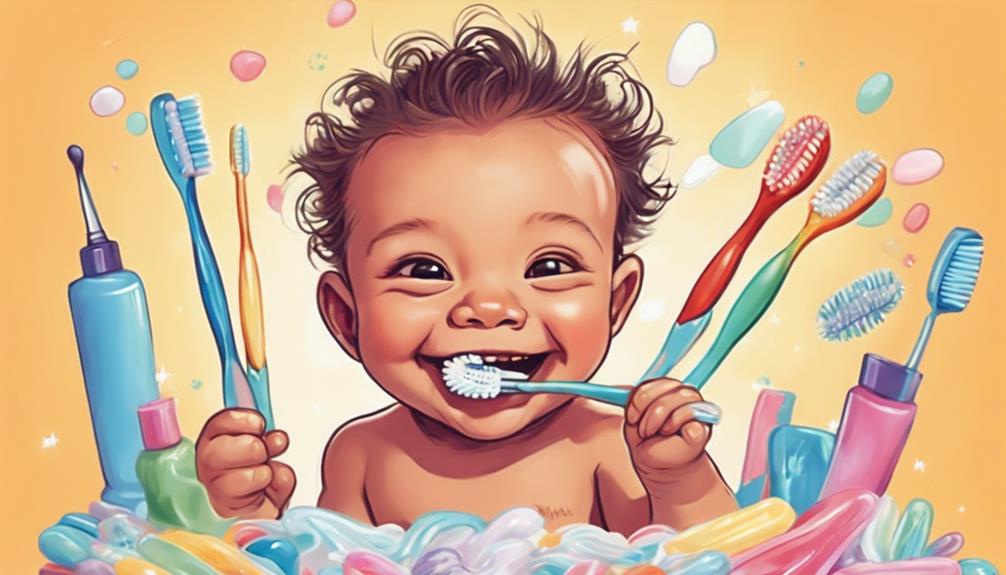
Establishing good oral hygiene for your baby is essential for preventing cavities and ensuring healthy teeth right from the start. You should begin by gently cleaning your baby's gums with a soft cloth even before the first tooth appears.
Once that first tooth emerges, it's time to introduce a soft-bristled toothbrush and a smear of fluoride toothpaste. This practice helps set the foundation for lifelong oral hygiene habits.
Here are a few key steps to follow:
- Brush twice daily: Teach your child to brush their teeth and gums twice each day.
- Visit the dentist: Schedule regular dental check-ups, starting by age 1 or when the first tooth erupts, to monitor their dental development.
Safe Teething Practices
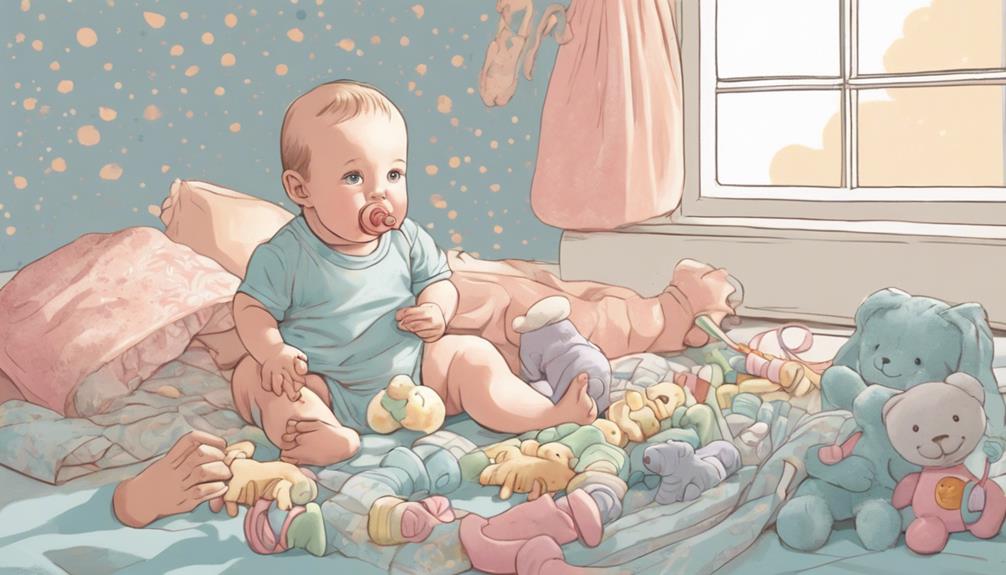
Teething can be a challenging time for both you and your baby, but following safe teething practices can help ease the process. Start by providing your baby with teething rings made from BPA-free materials. These are specifically designed for infants to chew on safely.
You can also offer clean washcloths that are chilled, which help soothe gum discomfort. Just make certain they're not frozen solid, as this can cause injury.
Always supervise your baby when they're using teething biscuits or toys to avoid choking hazards. It's crucial to choose products appropriate for their age and chewing ability.
Avoid teething items like amber necklaces, which pose strangulation and choking risks and lack scientific backing for effectiveness.
If your baby seems to be in significant pain, consult with a pediatrician before using any over-the-counter pain relief medications, particularly those containing benzocaine, as these aren't recommended for infants under 2 years.
When to See a Dentist
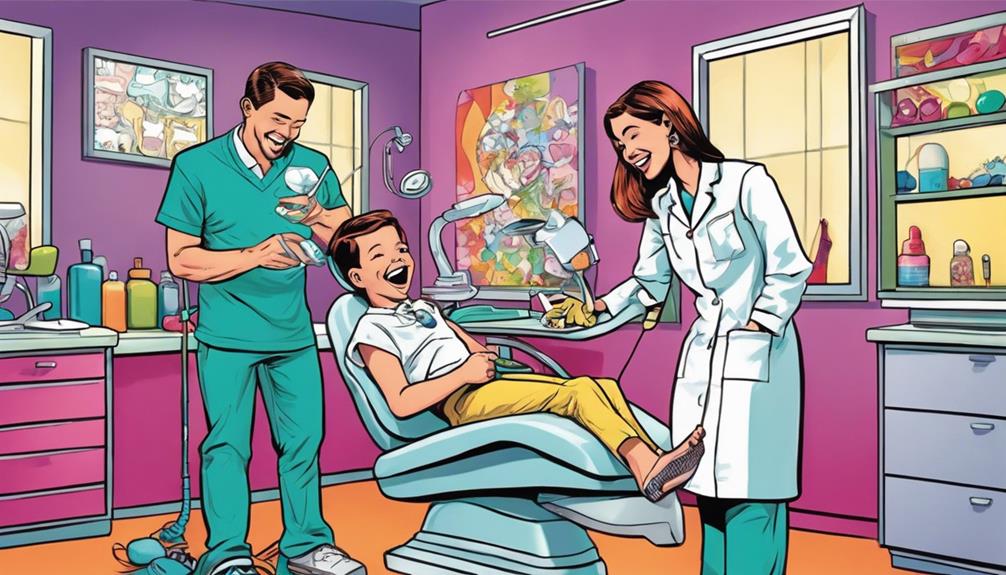
Knowing when to see a dentist is essential for guaranteeing your child's dental health as soon as their first tooth appears or by their first birthday. This early visit helps establish a foundation for your baby's oral care and allows you to address any concerns related to teething or dental hygiene.
Here are a few key points to keep in mind:
- Schedule your baby's first dental visit within six months after the emergence of their first tooth.
- Aim for regular dental check-ups starting at age one to monitor the development of your child's teeth by the time they're growing up.
If your baby is teething, it's also important to keep an eye out for any signs of dental issues. If you notice persistent tooth pain, discoloration, or difficulty chewing, don't hesitate to reach out.
Establishing a dental home early not only creates a routine for oral care but also guarantees timely interventions if any problems arise. Prioritizing these visits will help maintain your child's dental health for years to come.
Frequently Asked Questions
In What Order Do Babies Get Their Teeth?
When babies get their teeth, they typically start with lower central incisors, followed by upper central incisors, lateral incisors, first molars, canines, and finally, second molars, completing their primary set by age three.
What Teeth Do Babies Get First When Teething?
When teething begins, you'll notice your baby's lower central incisors popping up first. As the process continues, the upper central incisors will follow, bringing some relief to those sore gums and helping with feeding.
Which Teeth Are Most Painful for Babies?
When your little one's pearly whites start pushing through, expect the sharp canine teeth to be the most challenging. Their pointed edges can cause quite a bit of discomfort, making teething a tough journey for both of you.
What if Baby Gets Side Teeth First?
If your baby gets side teeth first, don't worry too much. It's not unusual and often indicates individual teething patterns. Just guarantee you maintain good oral hygiene and consult a pediatric dentist if you have concerns.
Is There a Specific Order in Which Baby Teeth Come In?
Yes, there is a specific order in which teeth babies get first. Typically, the bottom two front teeth, also known as the lower central incisors, are the first to appear, followed by the top two front teeth. Then, the teeth on either side of the front teeth will come in. This pattern of baby teeth eruption order is known as the “primary dentition sequence.” It is important for parents to keep track of their child’s tooth development as it can vary slightly from child to child. By understanding the typical order in which baby teeth come in, parents can better monitor their child’s dental health and identify any potential issues that may arise during the teething process. Additionally, knowing the baby teeth eruption order can help parents prepare for the dental milestones that their child will experience in the coming months.
Are the Order of Baby Teeth Eruption Patterns the Same for All Babies?
Yes, the order in which teeth babies first develop is generally the same for all babies. The first to appear are usually the bottom front teeth, followed by the top front teeth, then the molars, canines, and finally the back molars. However, exact timing can vary.
Conclusion
In summary, understanding your baby's teething journey can feel like maneuvering a wild rollercoaster ride!
Those first little teeth, usually the bottom front ones, are just the beginning of an exciting adventure.
While teething can bring discomfort, knowing how to soothe your baby and maintain their oral hygiene is essential.
Remember, it's never too early to start good dental habits.
If you're ever in doubt, don't hesitate to reach out to a dentist for guidance!
